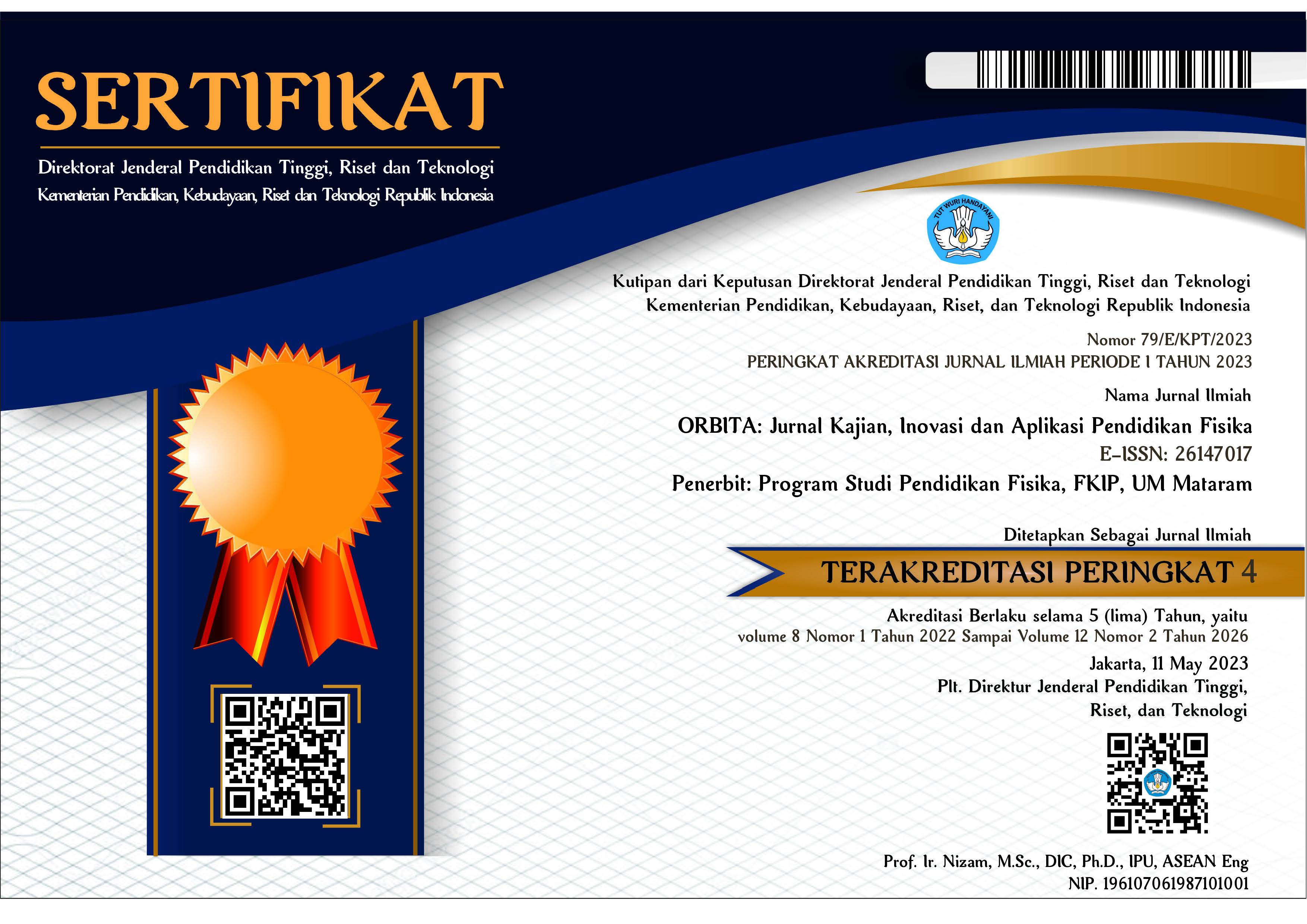STIMULASI KEMAMPUAN BERPIKIR MATEMATIS DALAM FISIKA MELALUI MEDIA SOSIAL
Abstract
ABSTRAK
Pembelajaran Fisika di tingkat perguruan tinggi telah banyak menggunakan media sosial sebagai media pembelajaran. Penelitian ini dilakukan untuk mengetahui pengaruh media sosial dalam menstimulasi kemampuan berpikir matematis (mathematical thinking skill) dalam pembelajaran Fisika di tingkat perguruan tinggi. Penelitian ini merupakan penelitian kuantitatif dengan menggunakan desain pengambilan data One Group Pretest-Posttest Design. Sebanyak 20 mahasiswa dipilih dengan metode purposive sampling menjadi responden penelitian. Perangkat yang digunakan berupa alat komunikasi smartphone. Aplikasi yang digunakan sebagai media pembelajaran yaitu media sosial WhatsApp dengan tambahan fitur International Phonetic Alphabet (IPA) Keyboard dan Math Keyboard sebagai stimulus matematis dan simbol-simbol pada persamaan Fisika. Pendekatan pembelajaran yang diterapkan adalah problem based-learning (PBL) dengan pokok materi Fisika Kinematika. Hasil penelitian menunjukkan bahwa terdapat peningkatan yang signifikan terhadap stimulasi kemampuan berpikir matematis mahasiswa sebelum menggunakan dan sesudah menggunakan media pembelajaran berupa media sosial WhatsApp dengan fitur tambahan Math Keyboard dan IPA Keyboard. Dengan demikian, media sosial dapat digunakan untuk meningkatkan kemampuan berpikir matematis dalam pembelajaran Fisika.
Kata kunci: berpikir matematis; fisika; media sosial; whatsapp
ABSTRACT
Physics learning at university level uses social media as a learning media. This research was conducted to determine the effect of social media in stimulating mathematical thinking skills on physics at university level. This research is a quantitative research and One Group Pretest-Posttest Design as data collection. A total of 20 students were selected by purposive sampling method as participants. Smartphone is used as a learning media and WhatsApp has choosen as social media to support physics learning. International Phonetic Alphabet (IPA) Keyboard and Math Keyboard installed on the WhatsApp to stimulate mathematics and symbols in Physics equations. The learning approach applied is problem based-learning (PBL) with Kinematics materials. The results showed that there was an increase in the stimulation of students' mathematical thinking skills before and after using WhatsApp as social media with additional features Math Keyboard and IPA Keyboard. Thus, social media can be used to improve mathematical thinking skills on Physics.
Keywords: mathematical thinking; physics; social media; whatsapp
Keywords
Full Text:
PDFReferences
al Mamouri, A. A. H., & Arrak, A. P. D. M. M. (2021). Evaluation of mathematical physics issues in the physics content of the preparatory stage according to the skills of inferential thinking. Ishraqat Tanmawia, 6(28).
Arbie, A., Satri, P. S. F., Setiawan, D. G. E., Nuayi, A. W., & Buhungo, T. J. (2021). Pengembangan perangkat pembelajaran team based learning-problem solving berbantuan whatsapp dan zoom meeting pada pembelajaran daring. ORBITA: Jurnal Kajian, Inovasi Dan Aplikasi Pendidikan Fisika, 7(2), 394–399.
Astutik, S., Bektiarso, S., Lesmono, A. D., Nuraini, L., & others. (2019). What can students show about higher order thinking skills in physics learning? IOP Conference Series: Earth and Environmental Science, 243(1), 12127.
Atabek, O., cSavkliyildiz, A., Orhon, G., Colak, O. H., Özdemir, A., & cSenol, U. (2022). The effect of anxiety on mathematical thinking: An fMRI study on 12th-grade students. Learning and Motivation, 77, 101779.
Auxier, B., & Anderson, M. (2021). Social media use in 2021. Pew Research Center, 1, 1–4.
Buhungo, T. J., Mustapa, D. A., & Arbie, A. (2021). Pengembagan perangkat pembelajaran team based learning-inquiry pada pembelajaran daring berbantuan whatsapp dan zoom meeting pada materi gerak lurus. Jurnal Pendidikan Fisika Dan Teknologi, 7(2), 147–152.
Campbell, S., Greenwood, M., Prior, S., Shearer, T., Walkem, K., Young, S., Bywaters, D., & Walker, K. (2020). Purposive sampling: complex or simple? Research case examples. Journal of Research in Nursing, 25(8), 652–661.
DeWitt, J., Archer, L., & Moote, J. (2019). 15/16-year-old students’ reasons for choosing and not choosing physics at a level. International Journal of Science and Mathematics Education, 17(6), 1071–1087.
Hake, R. R. (1998). Interactive-engagement versus traditional methods: A six-thousand-student survey of mechanics test data for introductory physics courses. American Journal of Physics, 66(1), 64–74.
Hamadi, M., El-den, J., Azam, S., & Sriratanaviriyakul, N. C. (2021). A novel framework for integrating social media as cooperative learning tool in higher education ’ s classrooms.
Irfan, M., Dhimmar, S., & others. (2019). Impact of WhatsApp messenger on the university level students: a psychological study. International Journal of Research and Analytical Reviews, 6(1), 572–586.
Jatmiko, B., Prahani, B. K., Suprapto, N., Admoko, S., Deta, U. A., Lestari, N. A., Jauhariyah, M. N. R., Yantidewi, M., & Muliyati, D. (2021). Bibliometric Analysis on Online Physics Learning during COVID-19 Pandemic: Contribution to Physics Education Undergraduate Program. Journal of Physics: Conference Series, 2110(1), 12018.
Kettler, T., Lamb, K. N., Willerson, A., & Mullet, D. R. (2018). Teachers’ perceptions of creativity in the classroom. Creativity Research Journal, 30(2), 164–171.
Lemay, D. J., Bazelais, P., & Doleck, T. (2021). Transition to online learning during the COVID-19 pandemic. Computers in Human Behavior Reports, 4, 100130.
Male, H., Murniarti, E., Simatupang, M. S., Siregar, J., Sihotang, H., & Gunawan, R. (2020). Atittude of undergraduate student’s towards online learning during covid-19 pandemic. PalArch’s Journal of Archaeology of Egypt/Egyptology, 17(4), 1628–1637.
Massolt, J., & Borowski, A. (2020). Perceived relevance of university physics problems by pre-service physics teachers: Personal constructs. International Journal of Science Education, 42(2), 167–189.
Matsun, M., & Saputri, D. F. (2020). Pengembangan E-Modul Fisika Berbantuan Whatsapp Sebagai Alternatif Pemebalajaran Dimasa Pemdemi Covid 19. ORBITA: Jurnal Kajian, Inovasi Dan Aplikasi Pendidikan Fisika, 6(2), 213–220.
Neumann, I., Sorge, S., Hoth, J., Lindmeier, A., Neumann, K., & Heinze, A. (2021). Synergy effects in learning? The influence of mathematics as a second subject on teacher students’ physics content knowledge. Studies in Higher Education, 46(10), 2035–2046.
Noori, A. Q., Orfan, S. N., Akramy, S. A., Hashemi, A., Noori, A. Q., Orfan, S. N., Akramy, S. A., & Hashemi, A. (2022). The use of social media in EFL learning and teaching in higher education of Afghanistan The use of social media in EFL learning and teaching in higher education of Afghanistan. Cogent Social Sciences, 8(1). https://doi.org/10.1080/23311886.2022.2027613
Nova, D. A. O., Dwikoranto, D., & Lestari, N. A. (2021). Analisis Persepsi Siswa Terhadap Pembelajaran Fisika Berbasis Ecopedagogy dengan Metode Daring Selama Pandemi Covid-19. ORBITA: Jurnal Kajian, Inovasi Dan Aplikasi Pendidikan Fisika, 7(1), 19–26.
Nst, M. H. (2022). PEMBERDAYAAN GURU DAN DOSEN SEBAGAI TENAGA PROFESIONAL. Al-Muaddib: Jurnal Ilmu-Ilmu Sosial Dan Keislaman, 6(2), 346–358.
Nuraeni, A., Nana, N., & Surahman, E. (2022). PEDAGOGICAL CONTENT KNOWLEDGE (PCK) MAHASISWA JURUSAN PENDIDIKAN FISIKA DALAM MEREDUKSI MISKONSEPSI PESERTA DIDIK PADA MATERI GERAK LURUS. ORBITA: Jurnal Kajian, Inovasi Dan Aplikasi Pendidikan Fisika, 8(1), 1–9.
Ornek, F., Robinson, W. R., Haugan, M. P., & Email, C. A. (2008). What makes physics difficult ? 3(1), 30–34.
Rahim, F. R., Sari, S. Y., Sundari, P. D., Aulia, F., & Fauza, N. (2022). Interactive design of physics learning media: The role of teachers and students in a teaching innovation. Journal of Physics: Conference Series, 2309(1), 12075.
Redish, E. F., & Kuo, E. (2015). Language of physics, language of math: Disciplinary culture and dynamic epistemology. Science & Education, 24(5), 561–590.
Ridwan, Y. H., Zuhdi, M., Kosim, K., & Sahidu, H. (2021). Pengembangan Media Pembelajaran Interaktif Berbasis Model Problem Based Learning Untuk Meningkatkan Kemampuan Berpikir Kreatif Fisika Peserta Didik. ORBITA: Jurnal Kajian, Inovasi Dan Aplikasi Pendidikan Fisika, 7(1), 103–108.
Rozal, E., Ananda, R., Zb, A., Fauziddin, M., & Sulman, F. (2021). The Effect of Project-Based Learning through YouTube Presentations on English Learning Outcomes in Physics. AL-Ishlah: Jurnal Pendidikan, 13(3), 1924–1933.
Safitri, A. A., Rahmadhany, A., & Irwansyah, I. (2021). Penerapan Teori Penetrasi Sosial pada Media Sosial: Pengaruh Pengungkapan Jati Diri melalui TikTok terhadap Penilaian Sosial. Jurnal Teknologi Dan Sistem Informasi Bisnis-JTEKSIS, 3(1), 1–9.
Sari, F. M., & Putri, S. N. (2019). Academic Whatsapp group: Exploring students’ experiences in writing class. Teknosastik, 17(2), 56–65.
Simatupang, M. S., & Peter, R. (2021). Redesign Online Learning During the Pandemic of Covid-19. The Asian ESP Journal, 17, 135–149.
Somantri, S. (2019). Pemanfaatan Whatsapp sebagai Upaya Meningkatkan Hasil Belajar Peserta Didik pada Mata Pelajaran Fisika. UPEJ Unnes Physics Education Journal, 8(1), 28–33.
Surahman, E., & Sujarwanto, E. (2021). Physics undergraduate students’ perceptions of online learning during the transition period to the new normal era. Journal of Physics: Conference Series, 1869(1), 12159.
Syafril, S., Latifah, S., Engkizar, E., Damri, D., Asril, Z., Yaumas, N. E., & others. (2021). Hybrid learning on problem-solving abiities in physics learning: A literature review. Journal of Physics: Conference Series, 1796(1), 12021.
Tafonao, T. (2018). Peranan media pembelajaran dalam meningkatkan minat belajar mahasiswa. Jurnal Komunikasi Pendidikan, 2(2), 103–114.
Uhden, O., Karam, R., Pietrocola, M., & Pospiech, G. (2012). Modelling mathematical reasoning in physics education. Science & Education, 21(4), 485–506.
Ventura, M., Moadebi, S., & Damian, D. (2021). Impact of motivational interviewing training on emergency department nurses’ skills: A one-group pretest--posttest pilot study. International Emergency Nursing, 56, 100980.
Wenno, I. H. (2015). The Correlation Study of Interest at Physics and Knowledge of Mathematics Basic Concepts towards the Ability to Solve Physics Problems of 7th Grade Students at Junior High School in Ambon Maluku Province , Indonesia. 2015.
Widiasih, W., Permanasari, A., Riandi, R., & Damayanti, T. (2018). The social media whatsapp to support physics learning problem solving on online tutorial activities in distance education. International Conference on Mathematics and Science Education of Universitas Pendidikan Indonesia, 3, 269–275.
Woitkowski, D., & Woitkowski, D. (2020). Tracing physics content knowledge gains using content complexity levels complexity levels. International Journal of Science Education, 1–24. https://doi.org/10.1080/09500693.2020.1772520
DOI: https://doi.org/10.31764/orbita.v8i2.11669
Refbacks
- There are currently no refbacks.

This work is licensed under a Creative Commons Attribution-ShareAlike 4.0 International License.
______________________________________________________
ORBITA: Jurnal Pendidikan dan Ilmu Fisika
p-ISSN 2460-9587 || e-ISSN 2614-7017
This work is licensed under a Creative Commons Attribution-ShareAlike 4.0 International License.
EDITORIAL OFFICE:


























